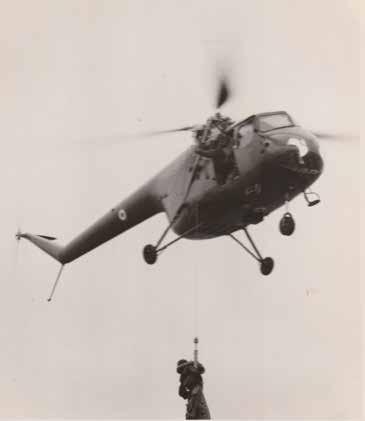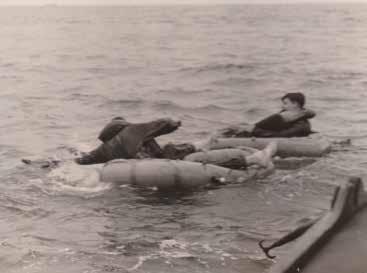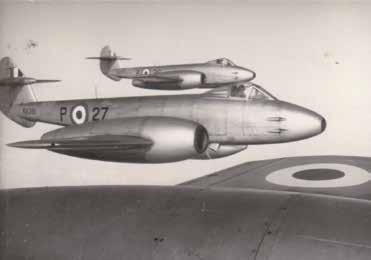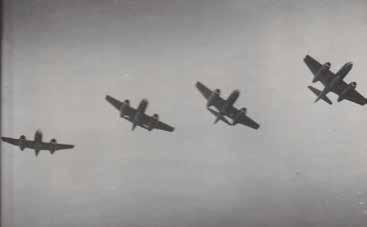
6 minute read
Fighter Pilot in the 1950’s
Although this record is written as a personal history, the main objective is to record the lifestyle and flying freedom of pilots which applied in the early 1950s.
by Graham Plumbe Flt Lt (ret)
Full Sutton, Yorkshire Having returned to England, the immediate task was to learn how to fly Meteors - Mks IV and VII (the two-seat trainer). That involved a 4-month course and a task which was very challenging. It involved asymmetric flying, aerobatics, formation, cross-country, and flame out landings. The most notable incident I can recall was when a student lost control resulting in a spin followed by a vertical dive. The speed was so great that on pulling out the wings bent somewhat, and wrinkles appeared in the fuselage. For good measure, the plane lost its ventral tank on hitting a potato clamp as it pulled out of the dive. How narrowly can one miss disaster?
While I was at Full Sutton, I had to take a driving test on motorcycles. At the end, the examiner, being chatty, asked what I did for a living. My reply - “fly jet fighters” - was a conversation stopper.
Stradishall, Suffolk At this Operational Conversion Unit, we were introduced to the Mk VIII Meteor, which was vastly better than the Mk IV. A main objective was a change in mental attitude; we were taught to ëstrap the plane to our backsidesí as opposed to sitting in the pilotís seat just to operate the controls. We were taught things like battle formation, low flying, aerobatics and quarter attacks on enemy aircraft.
Driffield, Yorks Pending a squadron posting, I was stationed briefly at Driffield, nominally as an education officer.
Church Fenton, York. Then, in Aug 1954 came the golden moment - posting to a squadron. 72 Sqn at Church Fenton, just outside York. Here we discovered just how many things a fighter pilot needs to learn - take-offs and landings, instrument flying, quarter attacks, cine recording of such attacks, aerobatics, spins, cross country navigation (high and low level), PI’s (pursuit and interception), tail chases, formation (close and open), asymmetric flying (not easy in a plane which has engines a long way out), flying at great height, GCAs (ground controlled approach), QGH (radio assisted descent through cloud), flag towing (for others to shoot at), and other exercises such as rat and terrier.
The practice quarter attacks were made on banners being towed by a colleague. The attacks used real bullets and hits were photo’d through one’s gunsight. We were taught to break off the attack at the point where the safety of the flag towing pilot was a factor, and if your camera caught a picture of the towing aircraft it was very expensive for your next visit to the mess bar!
One amusing incident in May 1955 was being asked to boat out into the North Sea with others to test a new type of exposure suit, mainly to see whether a ditched pilot could put it on before he froze. Being a willing guinea pig, I was first to leap overboard but had failed to trigger my suit inflation. I felt as if I was never going to reach the surface again. After I had climbed into the inflatable dinghy, I wasn’t quite ready for the pick-up Sycamore as I hadn’t quite finished donning my test suit. The result was that I was pulled out of the water before pulling my trousers up, and so was photo’d doing just that (see photo below). One training exercise was in the decompression chamber, where a guinea pig pilot (me again!) took his mask off until he went unconscious for want of oxygen at theoretical high altitude. This particular exercise was very valuable in recognising the effect of no oxygen, as sometime later I had a dogfight at c30,000 ft and suddenly realised that I was experiencing the light headedness which was a prelude to passing out. I immediately checked my oxygen tube and was alarmed to find it had become disconnected. That gave me a matter of seconds before passing out, so I went into an emergency dive to about 12,000ft where I could reconnect.
Perhaps the most memorable experience was the ‘phantom dive’. This was a feature of the Mk VII Meteor (trainer) in which asymmetric flying (1 engine throttled right back to simulate a flame-out) could lead to stalling of the inner wing and a resultant dive. I first met this when joining the squadron and being checked in by a flight commander, Flt Lt ‘Woody’ Woodyear in the rear seat. On finals, I lost control, went into a steep dive without the slightest idea of what was happening. It is shameful that this failing of Meteors was not explained before we flew. Woody seized his joystick
Part 2 of 3

Batchwood Flooring
Mk-IVs

and called ‘I have control’. He recovered the plane at about 150ft and later explained what had happened. Imagine my horror when, on taxying out of dispersal a month or so later, I saw in front of me an aircraft on the downwind leg suddenly rotate and crash with both pilots killed. It was Woody checking in the next pilot to join the Sqn. The phantom dive was referred back to Gloster (who made the Meteor) but as far I’m aware the fault was never corrected. Some years later, I attended the Farnborough Air show and was puzzled to see a Meteor, the middle section obscured by a notice board, but it had a Mk VII nose and a Mk VIII tail. On enquiry I was told that this was the Mk 71/2 which had been made to show that the tail was all important!
The squadron was flying Mk IVs when I first joined. They were bad aircraft, known as ‘brick-built s**t-houses!’. Happily, we soon converted to the Mk VIII. The most obvious difference was the shape of the tailfin as can be seen from the photos that follow. The third picture is of a Mk VIII which a colleague found so exciting that he overshot the runway on landing and the fire engines took over.
Batchwood flooring can supply and fit or provide fitting only, in Basingstoke, Hampshire and the local surrounding areas.

We are a husband and wife team and have been fitting for more than 13 years now.
We use wholesale flooring suppliers to order the flooring of your choice at the best price we can.
Word of mouth has contributed greatly to the building of Batchwood flooring and our success.
We supply and fit carpet, vinyl and LVT flooring and bring the samples to your home while we measure up.
Please contact us on 01256 362935 or email Batchwoodflooring@gmail.com
Alternatively take a look at our website https://batchwoodflooring.weebly.com
Batchwood Flooring
Supply and Fit Carpet and Vinyl
Jenny Batchelor
Sales representitive


You can also find Helicon online at:
www.rafmags.co.uk/magazines
To advertise in Helicon magazine contact Darren:








